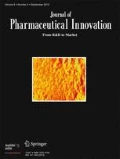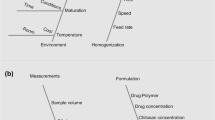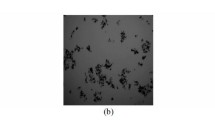Abstract
Purpose
In this study, polymeric microspheres containing diclofenac sodium were prepared by single emulsion (oil-in-water) solvent evaporation method and evaluated for their size, morphology, encapsulation efficiency, drug loading, and in vitro drug release.
Methods
Two nonbiodegradable polymers, Eudragit® RS100 and RL100 were used in combination. Microspheres were prepared by varying the amount of polyvinyl alcohol as a surfactant (0.05, 0.125, and 2.0 %, w/v) to the external phase; varying the amount of polymer (1:1, 2:1, and 3:1, w/w) to the drug by employing 32 full factorial design using the Design Expert (Version 8.0.7.1). The drug polymer interactions were investigated by Fourier transform infrared spectroscopy (FTIR) and X-ray powder diffractometry (XRPD). Imaging of particles was performed by field emission scanning electron microscopy.
Results
Graphical and mathematical analysis of the design showed a quadratic model was significant for the responses. Low magnitude of error and significant values of R 2 proves the high prognostic ability of the RSM. Encapsulation efficiency of microspheres (41.13 to 65.33 %) increases with an increase in surfactant concentration but decreases with an increase in polymer concentration. The microspheres were found to be discrete, spherical with smooth surface. The absence of drug polymer interactions was confirmed by FTIR spectroscopy. XRPD revealed the dispersion of drug within microspheres formulation. The Perfect pH-independent release profile was achieved from Eudragit® microspheres by anomalous transport mechanism.
Conclusions
In conclusion, Eudragit® microspheres containing diclofenac sodium can be successfully prepared, and seem to be promising for sustained release application.







Similar content being viewed by others
References
Arias JL, Lopez-Viota M, Lopez-Viota J, Delgado AV. Development of iron/ethylcellulose (core/shell) nanoparticles loaded with diclofenac sodium for arthritis treatment. Int J Pharm. 2009;382(1–2):270–6. doi:10.1016/j.ijpharm.2009.08.019.
Edelson JT, Tosteson AN, Sax P. Cost-effectiveness of misoprostol for prophylaxis against nonsteroidal anti-inflammatory drug-induced gastrointestinal tract bleeding. JAMA. 1990;264(1):41–7.
Barrier CH, Hirschowitz BI. Controversies in the detection and management of nonsteroidal anti-inflammatory drug-induced side effects of the upper gastrointestinal tract. Arthritis Rheum. 1989;32:926–32.
Pincus T, Griffin M. Gastrointestinal disease associated with nonsteroidal anti-inflammatory drugs: new insights from observational studies and functional status questionnaires. Am J Med. 1991;91(3):209–12.
Sostres C, Gargallo CJ, Arroyo MT, Ganas A. Adverse effects of non-steroidal anti-inflammatory drugs (NSAIDs, aspirin and coxibs) on upper gastrointestinal tract. Best Pract Res Clin Gastroenterol. 2010;24:121–32.
Thiefin G, Beaugerie L. Toxic effects of nonsteroidal antiinflammatory drugs on the small bowel, colon, and rectum. Joint Bone Spine. 2005;72(4):286–94. doi:10.1016/j.jbspin.2004.10.004.
Pilotto A, Sancarlo D, Addante F, Scarcelli C, Franceschi M. Non-steroidal anti-inflammatory drug use in the elderly. Surg Oncol. 2010;19(3):167–72. doi:10.1016/j.suronc.2009.11.014.
Lamprecht A, Torres HR, Schafer U, Lehr CM. Biodegradable microparticles as a two-drug controlled release formulation: a potential treatment of inflammatory bowel disease. J Control Release. 2000;69(3):445–54. doi:10.1016/S0168-3659(00)00331-X.
Herrmann J, Bodmeier T. Somatostatin containing biodegradable microspheres prepared by a modified solvent evaporation method based on W/O/W-multiple emulsions. Int J Pharm. 1995;126:129–38.
Yoo HS. Preparation of biodegradable polymeric hollow microspheres using O/O/W emulsion stabilized by Labrafil®. Colloids Surf B. 2006;52:47–51.
Polard E, Corre PS, Chevanne F, Verge RL. In vitro and in vivo evaluation of polylactide and polylactide-co-glycolide microspheres of morphine for site-specific delivery. Int J Pharm. 1996;134:37–46.
Bodmeier R, Chen H, Tyle P, Jarosz P. Pseudoephedrine HCL microspheres formulated into an oral suspension dosage form. J Control Release. 1991;15:65–77.
Li M, Rouaud O, Poncelet D. Microencapsulation by solvent evaporation: state of the art for process engineering approaches. Int J Pharm. 2008;363(1–2):26–39. doi:10.1016/j.ijpharm.2008.07.018.
Freitas S, Merkle HP, Gander B. Microencapsulation by solvent extraction/evaporation: reviewing the state of the art of microsphere preparation process technology. J Control Release. 2005;102(2):313–32. doi:10.1016/j.jconrel.2004.10.015.
Kilicarslan M, Baykara T. The effect of the drug/polymer ratio on the properties of the verapamil HCl loaded microspheres. Int J Pharm. 2003;252(1–2):99–109.
Eudragit Data Sheets. Industrial Product Division, Röhm Pharma GmbH, Weiterstadt, Germany; 2002.
Rowe RC, Sheskey PJ, Quinn ME. Handbook of pharmaceutical excipients. 6th ed. Washington, DC: Pharmaceutical Press and American Pharmacists Association; 2009.
Barzegar-Jalali M, Alaei-Beirami M, Javadzadeh Y, Mohammadi G, Hamidi A, Andalib S, et al. Comparison of physicochemical characteristics and drug release of diclofenac sodium–Eudragit RS100 nanoparticles and solid dispersion. Powder Technol. 2012;219:211–6.
Bas D, Boyaci IH. Modeling and optimization I: usability of response surface methodology. J Food Eng. 2007;78(3):836–45. doi:10.1016/j.jfoodeng.2005.11.024.
Chopra S, Patil GV, Motwani SK. Release modulating hydrophilic matrix systems of lasartan potassium: optimization of formulation using statistical experimental design. Eur J Pharm Biopharm. 2007;66:73–82.
Kehoe S, Kilcup N, Boyd D. Evaluation of cytotoxicity for novel composite embolic microspheres: material optimization by response surface methodology. Mater Lett. 2012;86:13–7. doi:10.1016/j.matlet.2012.06.087.
Kettaneh-Wold N. Use of experimental design in the pharmaceutical industry. J Pharm Biomed Anal. 1991;9(8):605–10.
Ragonese R, Macka M, Hughes J, Petocz P. The use of the Box–Behnken experimental design in the optimisation and robustness testing of a capillary electrophoresis method for the analysis of ethambutol hydrochloride in a pharmaceutical formulation. J Pharm Biomed Anal. 2002;27:995–1007.
Martins SA, Prazeres DM, Fonseca LP, Monteiro GA. Application of central composite design for DNA hybridization onto magnetic microparticles. Anal Biochem. 2009;391(1):17–23. doi:10.1016/j.ab.2009.05.006.
Jose S, Fangueiro JF, Smitha J, Cinu TA, Chacko AJ, Premaletha K, et al. Cross-linked chitosan microspheres for oral delivery of insulin: Taguchi design and in vivo testing. Colloids Surf B. 2012;92:175–9. doi:10.1016/j.colsurfb.2011.11.040.
O’Donnell PB, McGinity JW. Preparation of microspheres by the solvent evaporation technique. Adv Drug Deliv Rev. 1997;25:25–42.
Pund S, Joshi A, Vasu K, Nivsarkar MCS. Multivariate optimization of formulation and process variables influencing physico-mechanical characteristics of site specific release isoniazid pelletes. Int J Pharm. 2010;388:64–72.
Al haushey L, Bolzinger MA, Bordes C, Gauvrit JY, Briancon S. Improvement of a bovine serum albumin microencapsulation process by screening desing. Int J Pharm. 2007;344:16–25.
Joshi SA, Chavhan SS, Sawant KK. Rivastigmine-loaded PLGA and PBCA nanoparticles: preparation, optimization, characterization, in vitro and pharmacodynamic studies. Eur J Pharm Biopharm. 2010;76(2):189–99. doi:10.1016/j.ejpb.2010.07.007.
Krishnaiah D, Bono A, Sarbatly R, Nithyanandam R, Anisuzzaman SM. Optimisation of spray drying operating conditions of Morinda citrifolia L. fruit extract using response surface methodology. J King Saud Univ Eng Sci. 2012. doi:10.1016/j.jksues.2012.10.004.
Bolton S, Bon C. Pharmaceutical statitics practical and clinical application. 5th ed. New York: Informa Healthcare; 2009.
Fini A, Fazio G, Feroci G. Solubility and solubilization properties of non-steroidal anti-inflammatory drugs. Int J Pharm. 1995;126:95–102.
Gohel MC, Jani GK. Effects of selected formulation parameters on the entrapment of diclofenac sodium in ethyl cellulose microspheres. J Control Release. 1997;43:245–50.
Indian Pharmacopoeia Commission Ghaziabad. Indian Pharmacopoeia. 2010;562–587.
Korsemeyer R, Gurny RNP. Mechanism of solute release from porous hydrophilic polymers. Int J Pharm. 1983;15:25–35.
Wagner JG. Interpretation of percent dissolved-time plots derived from in vitro testing of conventional tablets and capsules. J Pharm Sci. 1969;58(10):1253–7.
Gibaldi M, Feldman S. Establishment of sink conditions in dissolution rate determination: theoretical consideration and application to nondisintegrating dosage forms. J Pharm Sci. 1967;56(10):1238–42.
Higuchi T. Rate of release of medicaments from ointment bases containing drugs in suspension. J Pharm Sci. 1961;50(10):874–5.
Higuchi T. Mechanism of sustained-action medication. Theoretical analysis of rate of release of solid drugs dispersed in solid matrices. J Pharm Sci. 1963;52(12):1145–9.
Cobby J, Mayersohn M, Walker GC. Influence of shape factors on kinetics of drug release from matrix tablets. II. Experimental. J Pharm Sci. 1974;63(5):732–7.
Hixson AW, Crowell JH. Dependence of reaction velocity upon surface and agitation. Ind Eng Chem. 1931;23:923–31.
Peppas NA. Analysis of Fickian and non-Fickian drug release from polymers. Pharm Acta Helv. 1985;60(4):110–1.
Harland RS, Gazzaniga A, Sangalli ME, Colombo P, Peppas NA. Drug/polymer matrix swelling and dissolution. Pharm Res. 1988;5(8):488–94.
Bamba M, Puisieux F, Marty J, Carstensen J. Mathematical model for release of drug from gel-forming sustained release preparations. Int J Pharm. 1979;3:87–92.
Meyer RH, Montgomery DC. Response surface methodology: process and product optimization using designed experiments. New York: Wiley; 2002.
Montgomery DC. Introduction to statistical quality control. 4th ed. New York: Wiley; 2008.
Ahad A, Aqil M, Kohli K, Sultana Y, Mujeeb M, Ali A. Formulation and optimization of nanotransfersomes using experimental design technique for accentuated transdermal delivery of valsartan. Nanomed-Nanotechnol. 2012;8(2):237–49. doi:10.1016/j.nano.2011.06.004.
Nayak AK, Pal D, Pradhan J, Hasnain MS. Fenugreek seed mucilage-alginate mucoadhesive beads of metformin HCl: design, optimization and evaluation. Int J Biol Macromol. 2013;54:144–54.
Shivakumar HN, Desai BG, Deshmukh G. Design and optimization of diclofenac sodium controlled release solid dispersion by response surface methodology. Indian J Pharm Sci. 2008;70:22–30.
Pignatello R, Ferro M, Guidi GD, Salemi G, Vandelli MA, Guccione S, et al. Preparation, characterisation and photosensitivity studies of solid dispersions of diflunisal and Eudragit RS100® and RL100®. Int J Pharm. 2001;218:27–42.
Paloma ME, Ballesteros MP, Frutos P. Analysis of diclofenac sodium and derivatives. J Pharm Biomed Anal. 1999;21:83–94.
Naik JB, Deshmukh RK, Kamble VV. Development of sustained released microparticles of diclofenac sodium using polymer complex by spray drier. Am J PharmTech Res. 2013;3.
Siepmann J, Peppas NA. Modeling of drug release from delivery systems based on hydropropyl methylcellulose (HPMC). Adv Drug Deliv Rev. 2001;48:139–57.
Mourao SC, da Silva C, Bresolin TM, Serra CH, Porta V. Dissolution parameters for sodium diclofenac-containing hypromellose matrix tablet. Int J Pharm. 2010;386(1–2):201–7. doi:10.1016/j.ijpharm.2009.11.022.
Acknowledgment
Authors are very much thankful to University Grants Commission, New Delhi for providing financial assistance (project reference no. F. no. 37-276/2009 (SR)) to carry out this research work. The authors gratefully acknowledge Natco Pharma Limited, (Hyderabad, India) and Evonik Degussa India Pvt. Ltd. (Mumbai, India) for providing the gift sample of DS and Eudragit (RS 100 and RL 100), respectively.
Declaration of Interest
The authors report no conflicts of interest. The authors alone are responsible for the content and writing of the paper.
Author information
Authors and Affiliations
Corresponding author
Rights and permissions
About this article
Cite this article
Deshmukh, R.K., Naik, J.B. Diclofenac Sodium-Loaded Eudragit® Microspheres: Optimization Using Statistical Experimental Design. J Pharm Innov 8, 276–287 (2013). https://doi.org/10.1007/s12247-013-9167-9
Published:
Issue Date:
DOI: https://doi.org/10.1007/s12247-013-9167-9




